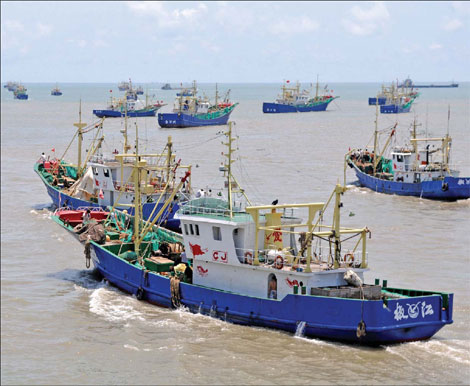Ocean of dreams
Updated: 2011-08-19 14:29
By Li Jingyu (China Daily European Weekly)
|
 China, with a sea territory of some 3 million sq km, should put an equal emphasis on the development of both the land and the sea. Jia Ce / for China Daily |
China must protect its maritime resources with firm resolve to safeguard economic, security interests
When psychologists and sociologists define China's national character from a geographic perspective, many of them tend to describe Chinese as "continental" rather than "oceanic".
This is the case of China. Although the nation, which was home to Zheng He, arguably the most famous navigator in ancient history, boasts a sprawling coastline of 18,000 km, the Chinese people have often lived off the land. In fact, the reliance on land reached a crescendo during the Ming (1368-1644) and Qing (1644-1911) dynasties, when both governments sealed off its coastal lines in a "close-door" strategy until Western powers opened them with gunboats.
The continental ethos was inherited even after the founding of the People's Republic of China in 1949. One piece of evidence is that Chinese school textbooks for several decades stipulate that China has a land territory of more than 9.6 million sq km but they do not mention the size of the county's sea territory - which is 3 million sq km.
However, things are changing.
The Chinese government seems to have been paying greater, if not unprecedented, attention to the ocean in recent years.
One of the latest signs was written in black and white in its 12th Five-Year Plan, a blueprint of the economic and social development from 2011 to 2015.
In the 62-chapter document endorsed by the National People's Congress, the country's top legislature, in March, "promoting the development of the ocean economy" for the first time became an independent chapter. It reads: "(China will) stick to coordinating the development of the land and the ocean, formulate and carry out the strategy of developing the ocean and enhance the ability of developing, control and comprehensively manage the sea."
The declaration is strong proof that China will put an equal emphasis on the development of both the land and the sea.
Even before the ocean strategy was spelt out in the 12th Five-Year Plan, some of the major coastal provinces had announced plans to shore up their marine economy.
The ocean dream comes in time, as fast urbanization and economic growth in past few decades have been depleting China's land resources. Take oil for example. The country used to be self-sufficient but it now has to import more than half of its crude.
Currently, biological production at territorial waters is about 302 tons per sq km, marine species have been up to 2,028 types, sea creatures at the tidal-flat area are about 2,950 kinds, breeding economical creatures are 238 kinds; sea fishing area covers 2.8 million sq km, areas suitable for artificial breeding of shallow water and beach area have been more than 1.33 million hectares.
In terms of mineral resources at the seabed, they are relatively abundant. It has been estimated that China's offshore oil resources are about 40.6 billion tons; marine gas resources about 8.4 trillion cubic meters; proven coastal sands reserves 1.625 billion tons; renewable marine energy power about 4 million to 5 million kilowatts. Also China's water resources are rich in the main to produce salt and for extraction of chemical elements like potassium, bromine and magnesium. In addition, China's coastal tourism resources are very rich, with a total development of more than 1,500 tourist attractions, including 273 important areas.
In an era of economic globalization, China must use its geographical ocean advantage, and actively follow up the revolutionary trend marine science creates, to become a powerful nation. It is impossible that China's strategic orientation of development can be separated from the orientation of its developing marine industry.
A country's competitiveness not only depends on its economy, trade and finance, but also on environment, culture, energy, military power, politics and many other elements. As countries around the world start to turn their attention to territorial waters, considered rich in resources, the importance of integrated indicators of sea is also growing.
In recent years, the status of China's National Offshore GDP has also started to be recognized, and in 2010 China's National Offshore GDP accounted for almost 10 percent of the national GDP.
According to statistics, in 2000 US marine industries' direct contribution to the US economy was around $117 billion (81.74 billion euros) with economic output in the coastal areas each year exceeding $1 trillion. If coastal watershed counties are also taken into account, the coastal contribution to the economy is around $4.5 trillion per year, accounting for over half of the total US GDP. In Japan, the value of the industrial output that marine industries produce accounts for half of the national GDP.
Compared with marine economy-developed countries such as Japan and the US, China still has a long way to go as the overall size of China's marine economy is still small and its role in boosting the national economy is not significant.
Other than the economic need, security is another major factor that fosters China's ocean ambitions.
China's marine rights and interests have been challenged by modern foreign powers in recent years and different levels of disputes on maritime delimitation in the Yellow Sea, the East China Sea and the South China Sea still exist. In China's waters, in addition to the Bohai Sea, which does not have any dispute of sovereignty with other countries, the Yellow Sea, the East China Sea and the South China Sea have overlap areas with eight countries. In other words, in the maintenance of maritime rights and interests, China is facing many urgent needs to deal with the issue of sovereignty.
In the area of the Yellow Sea, potential conflicts on demarcation exist among China, the Republic of Korea (ROK) and the Democratic People's Republic of Korea. In recent years, the ROK and the US have been holding joint military exercises in the Yellow Sea economic zone frequently, thereby threatening China's national security. In the East China Sea region, disputes on the sovereignty of the Diaoyu Islands exist among China, Japan and the ROK. In the South China Sea, large areas have become part of the economic zones in some Southeast Asian countries. Backed by Western powers, they often make predatory moves in the region.
Theses problems have seriously affected the country's maritime security and even national security.
Against this backdrop, the necessity for China to flex its muscles on the sea appears to be nothing but pressing, and it is very natural that the country's ocean dreams will grow bigger in the years to come.
The author is a professor at Liaoning Normal University.
E-paper

The snuff of dreams
Chinese collectors have discovered the value of beautiful bottles
Perils in relying on building boom
Fast forward to digital age
Bonds that tie China. UK
Specials

Let them eat cake
Cambridge University graduate develops thriving business selling cupcakes

A case is laid to rest
In 1937, a young woman'S body was found in beijing. paul french went searching for her killer

Banking on change
Leading economist says china must transform its growth model soon
